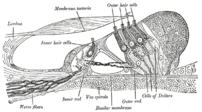
[amazon_link asins=’B06XHJRDL7,B01EHEIGOG,B000EX7LNM,B00C8P2WRO,B01K1CK74K,B01MYAXHNY,B01N0WMN8O,B0725LMF86,B002CX5WGK’ template=’ProductCarousel’ store=’finmeacur-20′ marketplace=’US’ link_id=’0da6c6a1-5195-11e7-8476-fde755c264e4′]
Researchers at Northwestern University in Chicago have made a new discovery that could lead to better cochlear implants for deaf people.
…………
Infrared light can stimulate neurons in the inner ear as precisely as sound waves, a discovery that could lead to better cochlear implants
They have found that infrared light can stimulate neurons in the inner ear as precisely as sound waves, reports New Scientist.
A healthy inner ear uses hair cells that respond to sound to stimulate neurons that send signals to the brain. However, hair cells can be destroyed by disease or injury, or can contain defects at birth, leading to deafness. In such cases, cochlear implants can directly stimulate neurons.
The hearing provided by implants is good enough to enable deaf children to develop speech skills that are remarkably similar to hearing children’s.
However, implant users still find it tough to appreciate music, communicate in a noisy environment and understand tonal languages like Mandarin and that’s because the implants use only 20 or so electrodes, a small number compared to the 3000-odd hair cells in a healthy ear.
More sources of stimulation should make hearing clearer but more electrodes cannot be packed in because tissue conducts electricity, so signals from different electrodes would interfere.
On the contrary, laser light targets nerves more precisely and doesn’t spread, which could allow an implant to transmit more information to the neurons.
In order to explore that idea, a research team led by Claus-Peter Richter at Northwestern University in Chicago shone infrared light directly onto the neurons in the inner ear of deaf guinea pigs.
At the same time, the researchers recorded electrical activity in the inferior colliculus, a relay between the inner ear and the brain cortex, producing a set of frequency “maps”.
These maps are a good indication of the quality of sound information sent to the brain.
Richter said that electrical stimulation of the inner ear by a cochlear implant produces blurred maps, but the light stimulation produced maps that were as sharp as those produced by sound in hearing guinea pigs.
While it’s a mystery how light stimulates the neurons, as they do not contain light-sensitive proteins, Richter hypothesizes the heat that accompanies the light may play a role, and his team is now investigating the long-term effects of heating neurons.
The findings were presented at the Medical Bionics conference in Lorne, in the Australian state of Victoria, earlier this week.
You may click to see:->
Light-wave implant hope for deaf
Original Signal-Transmitting Science
Light may bring sound to the deaf
Light opens up a world of sound for the deaf
Sources: The Times Of India
Related articles by Zemanta
- Gene therapy ‘may repair hearing’
- Bring Hearing to Children with Cochlear Implants
- Hearing Loss – Causes, Symptoms and Treatment
- Cochlear implants: a technology that’s changing deafness
- Picking Up Good Vibrations (With Limitations)
- GP’s deaf baby girl denied twin ear implants in ‘postcode lottery’
- Ears: There’s More to Ears Than Just Wax
![Reblog this post [with Zemanta]](https://i0.wp.com/img.zemanta.com/reblog_e.png?w=580)
